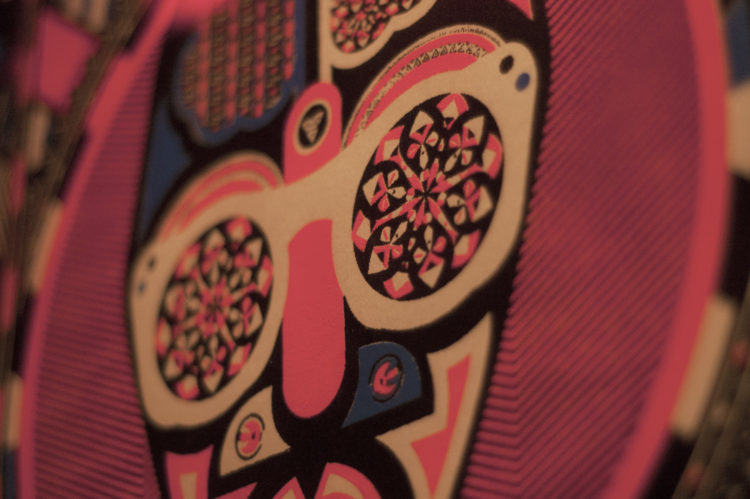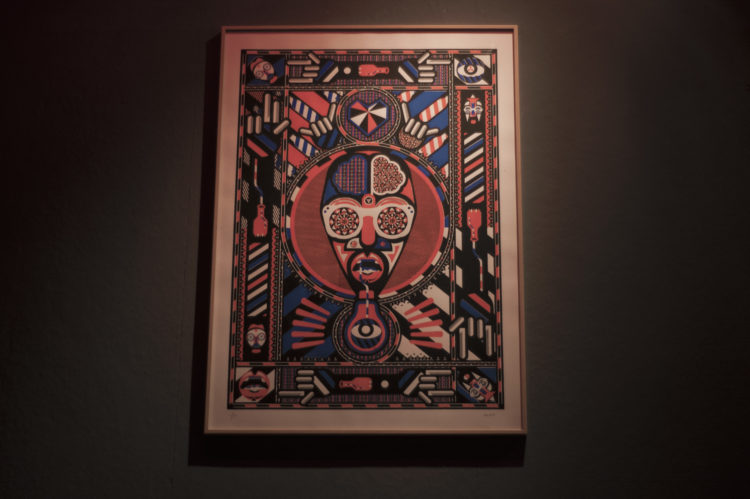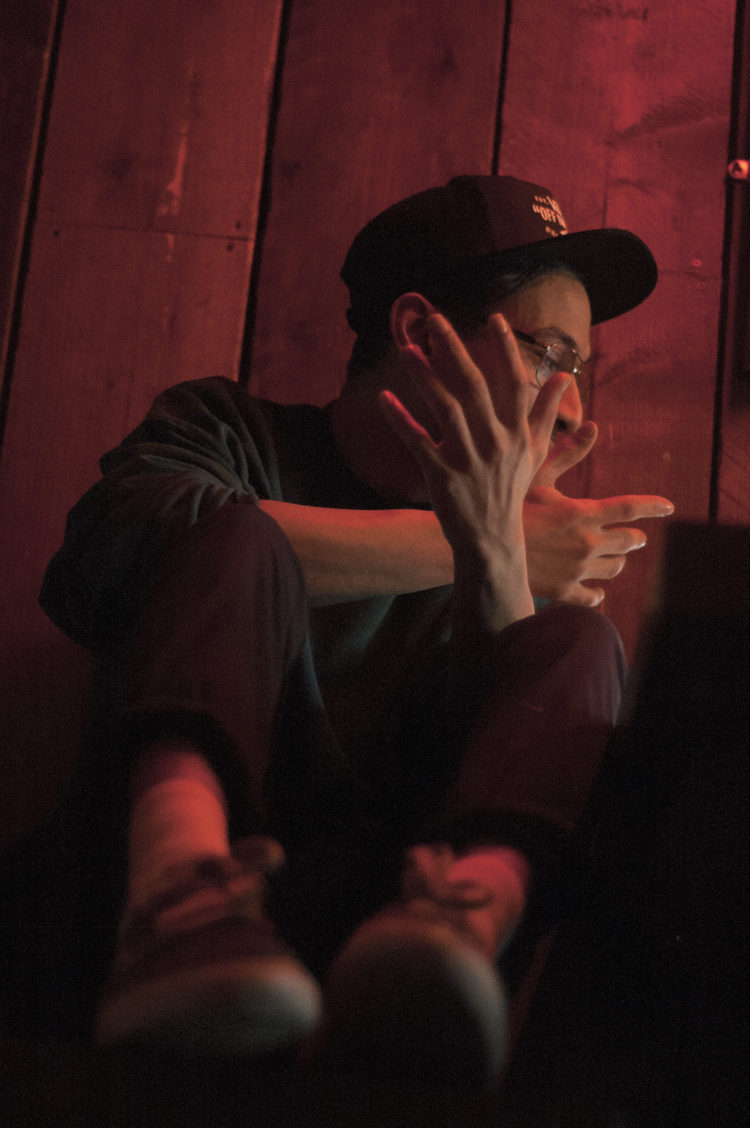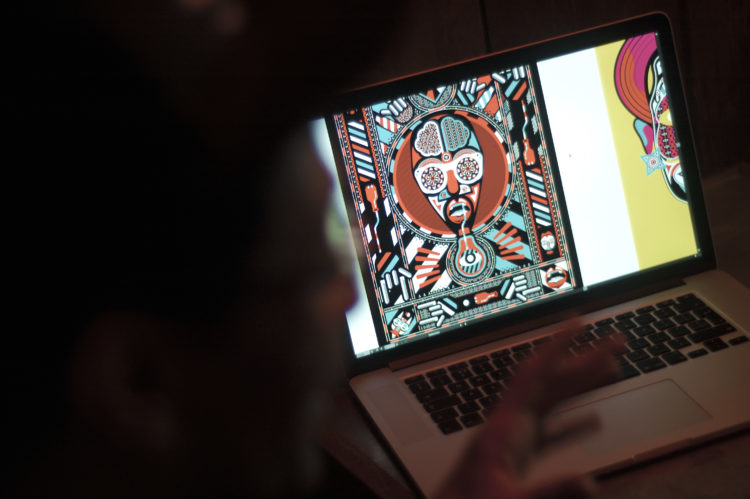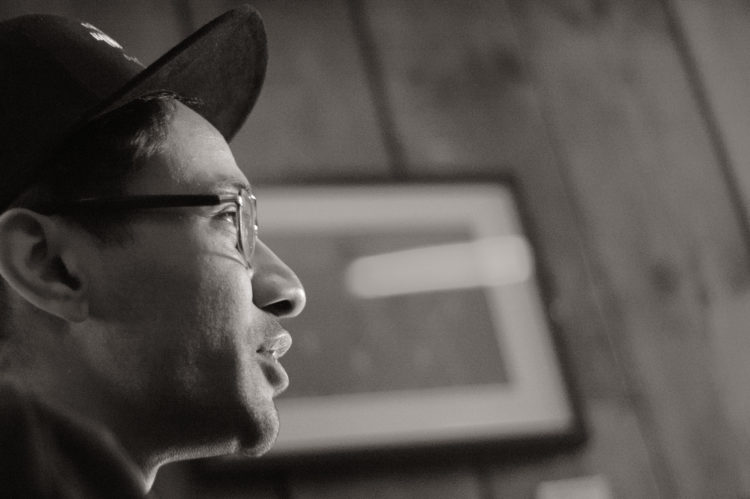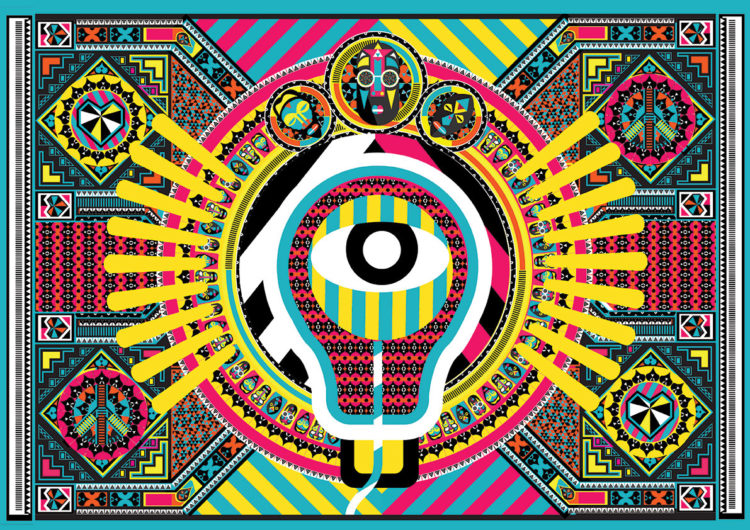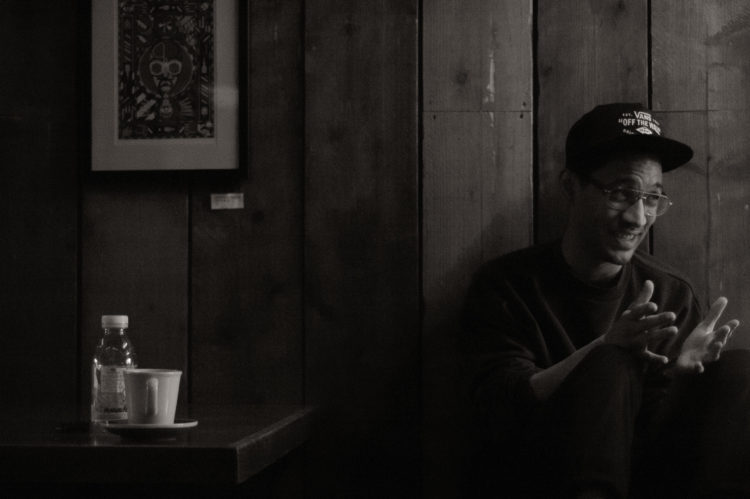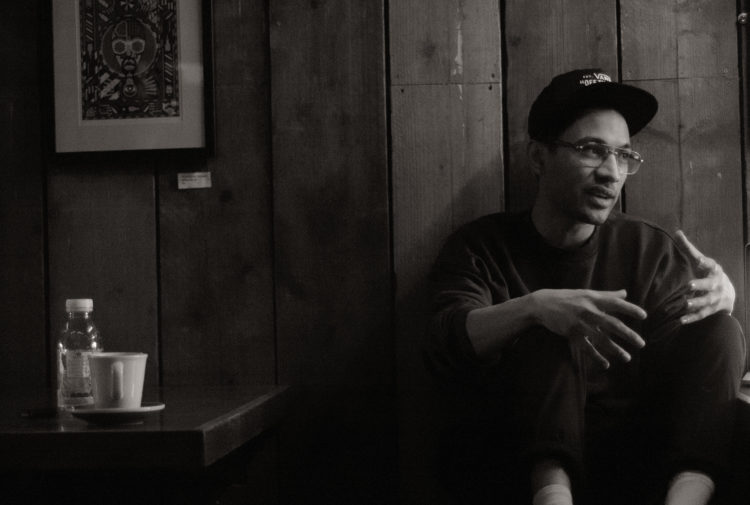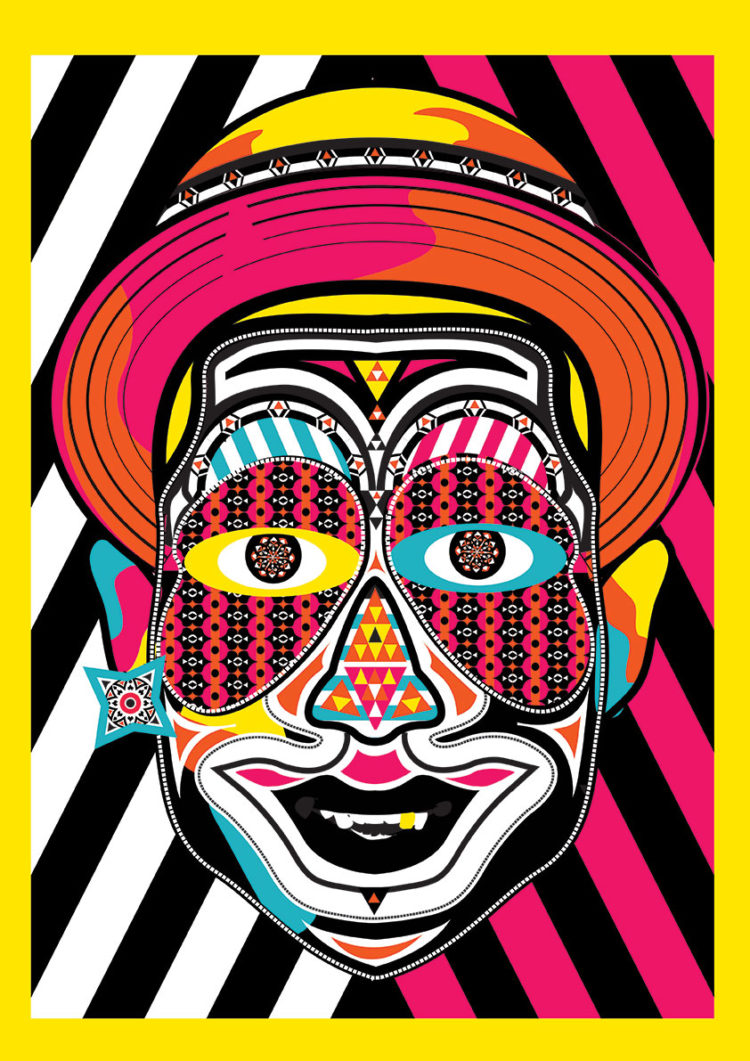The luminous face on the wall belongs to a crystal meth addict. He’s inhaling from a pipe made from a lightbulb, the straw slotted through the ‘passion’ gap in his teeth. His frontal lobes are visible, pulsating in a vortex of patterns. It’s called ‘The Monster’, Na-eem Hoosain explains. ‘This print is inspired by the effect of drugs.’
We’re at the Hoxton Square Bar & Kitchen, a tastefully gritty venue in East London, which is hosting the Vending Machine Art Gallery. I first met Hoosain there at the opening of the exhibition. He was with his father who looked very proud. You can buy the prints displayed on the wall stored in capsules in the vending machine opposite the bar.
https://www.instagram.com/p/BPqWFBagMyT/?taken-by=thevendingmachineartgallery
This is one of the first prints that Hoosain has put on the market. The British South-African 30-year-old creative director has, up till now, been concentrating on his career, recently moving from working as Senior Art Director at the fashion magazine i-D to gaming specialists Eye-D Creative where he looks after campaigns for Warner Bros, Universal and Red Bull.
We’re playing football and you’re surrounded by this bunch of zombies.
His art is influenced by his time growing up on the outskirts of the Cape Flats in Athlone. ‘We weren’t allowed to play outside because there were “Tik Monsters”.’ Addicts were a regular sight walking up and down the roads outside his house. ‘Because it wasn’t policed very well, they would walk around and smoke,’ he says. ‘We’re playing football and you’re surrounded by this bunch of zombies.’
Crystal meth – you might also call it Tik, Tina, Ice, Krank, Tweak – is a real problem in Cape Town. The medical journal The Lancet reported in 2008 that there could be as many as 200,000 tik users in and around the city. In 2002, only 1 per cent of the under 20-year-olds receiving treatment used tik as their first or second substance of choice. In 2008, it was 70 per cent. It’s hard to find more up-to-date data but there’s no reason to believe the rapid high has worn off.
It’s gangs. They are pushing the drugs. And they found a way to make tik and it’s killing our culture.
Hoosain’s own experience backs up the figures. ‘I’m on a WhatsApp group with friends in South Africa and it’s a daily occurrence that I get messages: “Do not drive down this road because three people have been killed” It’s gangs. They are pushing the drugs. And they found a way to make tik and it’s killing our culture. It’s taking over the youth.’
Crystal meth is highly addictive – more addictive than alcohol or dagga (cannabis). The drug seems to have been cooked up for typical teenage woes – side effects include feeling more confident, energetic and horny. Binges can last for days, with no sleep: more time to play video games and have sex. No wonder it’s popular. But with the high, comes a crashing low.
I have family that have been destroyed by crystal meth.
Tik users often suffer from extreme weight loss, dental problems known as ‘meth mouth’, skin sores from intense scratching as well as psychotic episodes and paranoia. This is a silver lining, says the Director of the Cape Town Drug Counselling Centre: tik users often seek treatment early; the high incidence of psychotic episodes early on ‘scares them’.
‘I have family that have been destroyed by crystal meth,’ Hoosain says. ‘It’s everywhere. It starts when you’re going out and it’s a cheaper alternative to drugs like cocaine. It’s so highly addictive that in a very short space of time it becomes part of their lives.
‘They can’t afford the pipes to smoke it with. They’re stealing light bulbs…. from people’s porches, from public toilets. There was a time when the actual cost of lightbulbs was more expensive in the Cape Flats because of this problem. It’s sad to see.’
Addiction is split on racial lines as about 90 per cent of patients are coloured. It is controlled by gangs within the community – whose hand signs border the print. The crystal meth scene is catnip for channels like Vice which publishes articles with the headline: Cruising the Meth-Riddled Murder Dens of Cape Town. So why did Hoosain, who is fiercely proud of his heritage, decide to highlight the dark underbelly of Cape Malay culture in an exhibition celebrating multiculturalism?
Part of what I want to do is celebrate the beauty of my culture and highlight the issues.
‘We are being seen, the Cape Malays, as the druggies. Part of what I want to do is celebrate the beauty of my culture and highlight the issues. It’s taking a dark situation and a dark memory of mine and trying to translate it into something beautiful.’
The Cape Malays are part of the coloured community in Cape Town – the Indians, Malaysians, Indonesians and others who did not fit into the strict black and white distinctions of the Apartheid government yet still suffered the ramifications.
His grandfather and step-grandmother were a mixed-race couple who sought political asylum in Great Britain. His mother was one of the 60,000 inhabitants during the 70s forcibly removed from District Six, a bustling cosmopolitan area in the centre of the city, to the Cape Flats township 25km away.
https://www.instagram.com/p/BPh5LjbhPTH/?taken-by=_notyetdefined
Hoosain was eventually born in London, the youngest of five children, but it could have been Cape Town: ‘We grew up in a home that was South African: we eat South African food; we speak Kombuis Afrikaanse. Identity became really important.’
These experiences seem to have made Hoosain consider Cape Malay culture a privilege.
‘One of my first memories was standing in Trafalgar Square as my father got to vote for the first time. For us, it was a defining moment because we’d heard so much about the struggles.’ On going back to live in Cape Town for university, Hoosain explains: ‘I experienced the results of what Apartheid had done to the second generation from a different perspective. I’d go into a store and I wouldn’t get served but the moment I opened my mouth and they heard I was English, it just changed.’
When he went back to Cape Town to study, Hoosain started to fully understand how Apartheid had affected his father’s life. Coloured people had been forbidden to go to many of the places he was now discovering. ‘It became a bonding experience talking to him about where I’d been. He’d always say: send me pictures. I’m talking about someone who spent 30 to 40 years in South Africa, who’d grown up there, and he’d seen nothing.’
There are so many different facets that make up South Africa, Cape Town and the Cape Malay community.
These experiences seem to have made Hoosain consider Cape Malay culture a privilege. It’s a culture born of the cosmopolitan history of Cape Town, which he tries to bring alive in his intricate brushwork: ‘What I’m trying to do is take all of these different influences that have made up who the Cape Malays really are and to find a way of visually representing us and finding a style that’s who we are,’ he speaks quickly, his words tripping over themselves.
He wants his community ‘to be proud of the Indian side, the Islamic side, the African geometry. There are so many different facets that make up South Africa, Cape Town and the Cape Malay community. They’re not proud. And that’s what’s happened with Apartheid.’
Hoosain emails me later, presumably worried that he’s been too negative – even though he shouldn’t be. ‘There is so much beauty in our culture, with a heritage of craftsmen, artisans, political activists, humble religious leaders and even royalty. And this is something all Cape Malays have great pride in. The people are warm, friendly, and very bubbly. Quite different from the conservative British lol.’
He’s now working towards his first solo exhibition in June. Meanwhile, he’s collaborating with fellow Cape Malay London-based DJ Esa Williams on a concept album inspired by the Klopse Carnival, a joyous annual parade of 13,000 or so Cape Malays dressed up as minstrels. It happens on January 2, the one day slaves were given as holiday before slavery was abolished in Cape Town in 1834.
This seems like the perfect project for the artist whose work is all about giving people visibility: ‘Part of what I want to do is to give Cape Malays a creative identity and a global identity so people understand who we are and that we exist.’
Photography by Shotbydk @shotbydk
The Vending Machine Art Gallery is on until March 25 at Hoxton Square Bar & Kitchen

